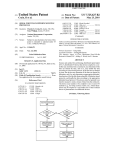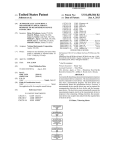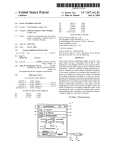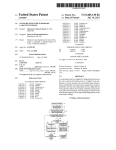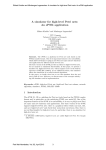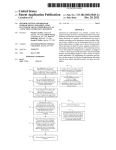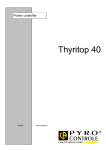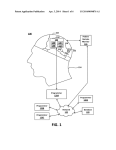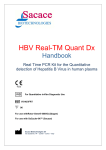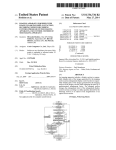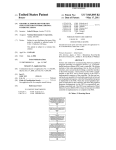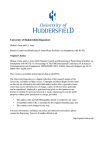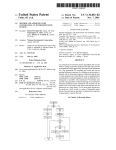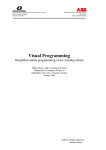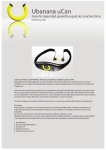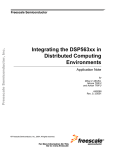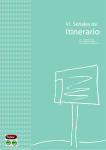Download Time-bounded program execution
Transcript
US007559060B2
(12) Ulllted States Patent
(10) Patent N0.:
Schmidt et al.
(54)
(75)
US 7,559,060 B2
(45) Date of Patent:
TIME-BOUNDED PROGRAM EXECUTION
Inventors: Darren K Schmidt, CedarPark, TX
Jul. 7, 2009
6,014,669 A *
1/2000 Slaughter et a1. ............ .. 707/10
6,076,157 A *
6/2000
Borkenhagen et a1. .... .. 712/228
6,161,193 A * 12/2000 Garg et a1. ................... .. 714/6
(Us); A1105?! VraI1¢i¢,AuSt1n, TX (Us);
6,185,577 B1 *
2/2001 Nainani et a1. .
satlshv- KllmarrAustlnr TX (Us)
6,189,022 B1*
2/2001 Binns ....................... .. 718/100
707/202
(73) Assignee: National Instruments Corporation,
Austin, TX (U S)
(*)
Notice:
(Continued)
Subject to any disclaimer, the term of this
patent is extended or adjusted under 35
OTHER PUBLICATIONS
U'S'C' 154(1)) by 992 days‘
LabVIEW Real-Time Module User Manual; Apr. 2003*
(21) Appl. No.: 10/784,866
(22) Filed:
(Continued)
Feb. 23, 2004
Primary ExamineriVan H Nguyen
Assistant ExamineriAbdullah Al KaWsar
(65)
Prior Publication Data
Us 2004/0255296 A1
Dec‘ 16, 2004
(74) Attorney, Agent, or FirmiMeyertons Hood Kivlin
KoWert & GoetZel, P.C.; Jeffrey C. Hood; Mark S. W1ll1ams
Related US. Application Data
(60)
(51)
(52)
(58)
(57)
ABSTRACT
Provisional application No. 60/477,388, ?led on Jun.
10, 2003.
System and method for performing time-bounded execution
IIlt- Cl-
of a program. A timed program execution process is initiated,
and a timeout process is initiated. A timeout condition is
G06F 9/46
(2006-01)
G06F 9/44
(2006-01)
con?gured in the timeout process at a ?rst priority level, and
a rollback state determined for the program. Execution of the
G06F 11/00
(2006.01)
US. Cl. ..................... .. 718/100; 718/102; 718/104;
717/124; 717/127; 717/128; 717/129; 717/131;
714/2; 714/34; 714/48; 714/55
program is initiated in the timed program execution process at
a second priority level beloW the ?rst priority level. During
execution of the program, the timeout process determines if
the timeout condition has occurred, and if so, the timeout
Field of Classi?cation Search ........... .. 718/1e108;
process restores the execution of the program to the rollback
714/17, 34, 2, 15, 55, 48; 712/23, 234, 228;
state, and the timed program execution process resumes
7 17/ 174, 11, 168e178, 12(L131
See application ?le for complete Search history,
execution of the program from the rollback state With the
timeout condition. The program exits in the timed program
_
(56)
execution process in response to the timeout condition, and
References Clted
the timeout event disabled. The timeout process is terminated,
and the timed program execution process is terminated.
U.S. PATENT DOCUMENTS
5,530,802 A *
5,944,778 A *
6/1996
8/1999
Fuchs etal. ................. .. 714/17
Takeuchiet a1. .......... .. 718/100
27 Claims, 13 Drawing Sheets
Pericrrrr Time-Bounded
Execullon oi Program
m
sci sxacullon priprily level oi rirrred
program execution process in
second priority level (below ?rst
priority level of timeout process)
532
dererrrrirre rollback poim lrr program
1134
YE
limsoul event’!
NO
execute program
@
VES
mom will dimn
rograrii ex rrliorii
perform procrerrr exil procedure
w
rollback program and
resu Ina execution
irom rollback pulnt
US 7,559,060 B2
Page 2
US. PATENT DOCUMENTS
6,230,181 B1 *
5/2001
Mitchell et a1. ........... .. 718/100
6,269,478 131*
7/2001 Lautenbach-Lampe
6,484,276 Bl*
8/2002 Chamberlam -11/2002
Singh eta1~ ----- --
2/2007 Abrashkevich et a1. .... .. 711/170
7/2008 Shibayama et a1.
7,409,671 B1 >1<
8/2008
2003/0140334 Al*
et a1. ..... ................. .. 717/127
6,438,749 131*
7,181,585 B2 *
7,406,688 B2*
718/102
Meredith et a1‘ """"""" “ 717/104
7/2003 Granston etal. .......... .. 717/125
2004/0015924 A1
1/2004
717/174
2004/0064817 Al*
4/2004
Hah et 31‘
Shibayama 61:11. ....... .. 718/104
714/41
2004/0158549 Al*
8/2004
Matenaetal.
............... .. 707/1
6,584,601 B1 *
6,892,331 B2*
6/2003 Kodosky et a1.
.. 716/4
5/2005 Da Palma @1211. ........... .. 714/55
OTHER PUBLICATIONS
7’039’0l2 B2 :
5/2006 Nakéino et al' """""" " 370/230
“Timing a LabVIEW Operation”; Technical Note 022; Oct. 1992; 3
pages;Nationallnsnumentscorpomtiont
7,043,728 B1
5/2006 Galp1n ........... ..
7,093,249 B2*
8/2006
7,178,062 B1 *
2/2007 Dice ......................... .. 714/38
Melamed et a1. ..
718/102
. 718/100
* cited by examiner
US. Patent
Jul. 7, 2009
i
“1
Sheet 1 0f 13
US 7,559,060 B2
SCoymsputemr
82
1AFigure
US. Patent
Jul. 7, 2009
Sheet 2 0f 13
-E25:2U5H: / LEm2SwQE>o
\26z5<2>s vim
US 7,559,060 B2
om
293m
US. Patent
Jul. 7, 2009
Sheet 3 0f 13
US 7,559,060 B2
68:520 m2
8wE52o3m
F
3
US. Patent
Jul. 7, 2009
Sheet 4 0f 13
US 7,559,060 B2
Ha =.'2 9352
98-59652:8,‘
V
2:5 iQ20
258$<
268E9a
(am/K
6:80
mmat
US. Patent
<m25m
Em_n vm
6:920
Mm
Jul. 7, 2009
Sheet 5 0f 13
US 7,559,060 B2
26Emm
US. Patent
102
Jul. 7, 2009
A
Sheet 6 0f 13
122:
1 2\
@A0013{4150m4
US 7,559,060 B2
‘(0)
FIG.4
US. Patent
Jul. 7, 2009
Sheet 7 0f 13
US 7,559,060 B2
a
BoEm $=obc @|
Ebmo_E>
UEma
9a250 _23x2>0
I| 3?
/
8mno:
g
\
\
aNF
K_
$m=9aEmo0
m9
/cmSIPohawcmqxm
[email protected]
892E82251m.>0:532
239mm
US. Patent
Jul. 7, 2009
Sheet 8 0f 13
US 7,559,060 B2
set timeout condition in a ?rst
process
90.2
initiate execution of a program in a
second process
@‘l
i
the ?rst process determines if the
timeout condition occurs during
program execution
@
timeout condltlon.
-
' '
9
w
YES
the ?rst-process restores program to
pre-de?ned point in program
@
i
the program exits from the pre
de?ned point
w
Figure 6A
program exits normally
E
US. Patent
Jul. 7, 2009
Sheet 9 0f 13
initiate timed execution process
612
initiate timeout process
.Ql‘l
i
set timeout event
.612
i
perform time-bounded execution of
program
@
l
disable timeout event
E
l
terminate timeout process
2
i
terminate timed program execution
process
622
Figure GB
US 7,559,060 B2
US. Patent
Jul. 7, 2009
Sheet 10 0f 13
US 7,559,060 B2
Perform Time-Bounded
Execution of Program
w
i
set execution priority level of timed
program execution process to
second priority level (below first
priority level of timeout process)
Q2
determine rollback point in program
&
.
exit
tlmeout event.9
E
execute program
@
YES
lmeout event durin
rogram execution’?
rollback program and
resume execution
from rollback point
@2
perform program exit procedure
@
Figure 6C
US. Patent
Jul. 7, 2009
Sheet 12 0f 13
US 7,559,060 B2
l
2
I
|
|Loop
l
I
I
|. Initialize
||. Setl
Timeout
Timeout]
Process
Event |
l
>
i
|
l
V
H Run
'
P gram(s)
|
“1- Disable
->
Timeout
Event
>
uninitialize
.
Timeout
Process
i
l
I
l
/ I
\
sleeping
Start
\
\ \
Timeout ?res
Th
read A
1---------------------------- "M
Timer
'
Thread B
Set Priority
Program Execution
t
Store Resource State
t
Set Rollback State
‘k
<
_
_
No
_
_
:
Normal Execution Path
‘"1
'
—- — ->
Restore Resource State
l
—> Exit Code
Execution path before timeout
—- — —
*
Execution path after timeout
Point where rollback state was determined
Figure 8
US. Patent
Jul. 7, 2009
Initialize Timed
Sheet 13 0f 13
‘Time-Bounded Proqram'
Execution
ecution
US 7,559,060 B2
nlnitialize 'l'lmed
er Iteration
Execulion
Stair-l: E‘l’ilned
Stop Tuned
' Execution “
‘Execution
Q!’
9@
m
m
UTE: 1‘his VI's‘ execution 'ri'or
is set to tir'hekritical.
Figure 9
US 7,559,060 B2
1
2
TIME-BOUNDED PROGRAM EXECUTION
dimensions makes the transition to an iterative form expen
sive in resource usage or computationally intensive. For
PRIORITY DATA
example, consider blob analysis programs or algorithms
designed to determine connected collections of pixels (blobs)
having the same pixel value. While these algorithms iterate
through the image sequentially, their execution time and stor
This application claims bene?t of priority to Us. Provi
sional Patent Application Ser. No. 60/477,388 titled “Time
Bounded Program Execution” ?led Jun. 10, 2003, and Whose
inventors Were Darren R. Schmidt, AljosaVrancic, and Satish
age are directly related to the number of blobs found in an
input image. According to determinism requirements, execu
Kumar.
tion time and resource usage should not vary over different
valid inputs. Hence, these programs or algorithms are not
FIELD OF THE INVENTION
suited for deterministic execution. Algorithms for pattern
matching and edge detection have similar challenges that
The present invention relates to real-time program execu
tion, and more particularly to a system and method for time
bounded program execution.
make determinism unfeasible.
Thus, improved systems and methods for time-bounded
program execution are desired.
DESCRIPTION OF THE RELATED ART
Many industrial systems require real-time operation, such
as for example, automated manufacturing, control, and qual
ity control, Where an algorithm or operation (or set of opera
tions) must be performed under strict time limitations for
SUMMARY OF THE INVENTION
Various embodiments of the present invention provide for
20
each of a series of items, e.g., on a moving assembly or
manufacturing line. Increasingly, such operations are per
formed by computer-implemented systems Where a computer
25
system, in conjunction With various other devices such as
thread. It should be noted that in other embodiments, the
cameras, motion control devices, and so forth, executes one or
second process may include tWo or more execution threads or
more programs to perform the operation(s).
Real-time systems often provide execution environments
that facilitate deterministic program or algorithm perfor
processes (e.g., a plurality of second threads). Note that in
30
mance, Where in this context, the term “deterministic” refers
rithm) in substantially constant time. In other Words, a deter
ministic program may be expected to execute and return a
35
occur, the ?rst process may restore the program to a pre
de?ned state in the program, referred to as the rollback state.
sub-routine, dynamic linked library, or any other set of pro
gram instructions executable to perform a function, opera
40
tems are deterministic. In fact, most real-time programs are
not deterministic due to a number of restrictions determinism
entails or imposes. First and foremost, the program’s resource
needs during execution need to be knoWn a priori. OtherWise,
requests from the system for dynamically allocated resources
execute the program from the rollback state With the error
50
thread) may resume execution of the program from the roll
back state. In a preferred embodiment, the program may
resume execution from the rollback point.
Finally, the program may exit in the second process in
(timeout) condition. In other Words, the second process (e. g.,
response to the timeout condition, e.g., With an error code
indicating that program execution Was interrupted. In other
Words, the program did not complete execution before the
timeout occurred, and so the program execution may be inter
55
algorithms.
Because determinism generally imposes severe restric
60
tions on program design and resource usage, it is generally
impractical or impossible for most complex programs or
algorithms to be converted to a form that executes determin
istically. For example, in the ?eld of vision algorithms, such
as used in machine vision applications, virtually all programs
operate on images containing tWo distinct dimensions of data
that are spatially related. This interrelationship betWeen
In a preferred embodiment, the rollback state includes a roll
back point in the program from Which the program may exit
normally, e.g., With a timeout condition.
Once the program has been restored to the pre-de?ned
state, e.g., to the rollback state, the second process may
45
may be made and resource contention cannot be ruled out.
This requirement alone removes a large set of algorithms as
candidates for deterministic execution. As noted above,
another restriction imposed by determinism is that program
execution should complete in substantially the same amount
of time for all valid inputs. This is a signi?cant hurdle to
overcome for input domains that are multi-dimensional,
because the siZes and number of the dimensions in?uence the
execution time of the program. These factors force most
deterministic algorithms to be iterative in nature, and may
also restrict processing to small data sets or usually a single
data point, resulting in What are referred to as point-by-point
programs, i.e., the program may comprise a set of programs.
During execution of the program, the ?rst process may
determine if the timeout condition has occurred, and if the
timeout condition has not occurred, then the program may
complete and exit normally. If the timeout condition does
tion, or may refer to a portion of an application, such as a
tion, or task.
HoWever, not all programs that execute on real-time sys
some embodiments, execution of the program may include
execution of a plurality of programs. For example, in one
embodiment, the program may include one or more sub
to execution of the program (i.e., performance of the algo
result for any valid input set in substantially the same amount
of time. The term “program” may refer to an entire applica
time-bounded execution of programs, such as in real-time
applications. In one embodiment, a timeout condition may be
set in a ?rst process, e.g., a ?rst thread. For example, a timeout
event may be con?gured or set, such that the event Will ?re
When a speci?ed amount of time has elapsed. Execution of a
program may be initiated in a second process, e.g., a second
65
rupted and reset for subsequent execution.
It should be noted that in preferred embodiments, the
method described above may be performed iteratively, Where,
for example, each time-bounded program execution (Whether
timed-out or not) corresponds to one of a series of items,
events, or processes, such as in an automated manufacturing
or inspection system. For example, once the program has
exited normally, the method may return to the set timeout
condition step above, and continue as described, e.g., per
forming the time-bounded execution of the program in an
iterative manner, e.g., executing the program for each of a
plurality of items, e. g., objects on a conveyor belt, etc. Simi
larly, once the program has exited With the timeout condition,
US 7,559,060 B2
4
3
the method may proceed back to setting the timeout condi
If the timeout event has not occurred, the program may be
executed; otherwise, the method may exit. During program
tion, and continue as described above.
In another embodiment of the present invention, a timed
program execution process may be initiated, Where the timed
program execution process is operable to execute a program
in a time-bounded manner. In a preferred embodiment, the
timed program execution process comprises a ?rst execution
thread.
Then, a timeout process may be initiated. In one embodi
ment, the timeout process executes at a ?rst priority level. In
a preferred embodiment, the timeout process comprises a
second execution thread. In one embodiment, initiating the
execution, if the timeout event occurs, the timeout process
may restore the execution state of the timed program execu
tion process to the rollback state (and disable the timeout
event), and the timed program execution process may resume
executing the program from the rollback state. As noted
above, the rollback state may include a rollback point in the
program, and so the second process may resume execution of
the program from the rollback point.
Finally, a program exit procedure may be performed. In
one embodiment, performing the program exit procedure
may include clearing the rollback state, e.g., clearing the
rollback point. In one embodiment, the program may exit
timeout process may be performed by the timed program
execution process.
A timeout event may then be con?gured or set. Note that
With an error code indicating the timeout condition, as
described above.
As noted above, in one embodiment, the method may
include iteratively performing time-bounded execution of a
the timeout event may be based on a timer, a signal from an
external process, and/or any other type of event. For example,
a control process or sensor on a conveyorbelt or assembly line
may send a signal indicating that a next item has arrived, and
so indicate that the time period for processing the current item
is over, and that the time period for processing the next item
20
is to begin.
The timed program execution process may then perform a
time-bounded execution of the program (or a plurality of
programs). In one embodiment, the execution of the program
may be performed at a second priority level, Where the second
priority level is beloW the ?rst priority level. In other Words,
the process that executes the program preferably operates at a
priority level beloW that of the timeout process, so that the
timeout process can reliably preempt the execution process as
25
30
plurality of programs. For example, in one embodiment,
iteratively performing the time-bounded execution of a plu
rality of programs may include performing the method
described above for each of the plurality of programs.
In one embodiment, performing the program exit proce
dure may also include: if the timeout event has occurred,
storing an indication of a timeout condition, Where the timed
program execution process performing a time-bounded
execution of the program includes performing the method
above for each program only if the timeout condition is not
indicated.
Thus, in a preferred embodiment, each of the methods
necessary. A preferred embodiment of the program execution
described herein may be performed in an iterative manner,
step is described beloW.
Where each program (or each of a set of programs) is per
As noted above, in one embodiment, the method may
execute a plurality of programs. For example, the time
bounded program execution may be performed in an iterative
manner, Where at each iteration a respective program is
executed.
The timeout event may then be disabled, and the timeout
process may be terminated. In other Words, “cleanup opera
tions” for the timeout process may be performed. In one
embodiment, once the timeout event has been disabled, the
method may return to setting the timeout event and may
execute the program (or programs), proceeding as described
above. In other Words, the program or programs may be
performed iteratively, Where for each iteration the timeout
event is set, the program executed, and the timeout disabled,
formed as described above for each of a plurality of items,
processes, or events, such as, for example, items on an assem
35
bly line or conveyor belt. In an embodiment Where the pro
gram includes one or more sub-programs, or Where the pro
gram comprises a set of programs, executing the program
may include performing the above steps for each of the one or
more sub-programs or for each of the set of programs. In other
40
Words, the priority level set for the program may apply to each
of the sub-programs or the set of programs.
In one embodiment, setting the execution priority level of
the timed program execution process may include storing an
original execution priority level of the timed program execu
45
tion process prior to setting the execution priority level of the
times. Finally, the timed program execution process may be
terminated.
Thus, the timed program execution may be performed for
each item in a series of items being processed or analyZed,
e.g., items queued for processing on the assembly line or
50
timed program execution process. In this embodiment, per
forming the program exit procedure may also include restor
ing the execution priority level of the timed program execu
tion process to the original execution priority level.
In one embodiment, initiating the timeout process may
conveyor belt. A more detailed embodiment of the timed
55
e.g., for each ofa plurality of items, e.g., on an assembly line
or conveyor belt. Thus, each program (or set of programs)
may be performed in a time-bounded manner a plurality of
program execution step folloWs.
As described above, in one embodiment, an execution pri
or‘ity level of the timed program execution process may be set
to a second priority level, Where the second priority level is
beloW the ?rst priority level.
A rollback state in the program may be determined, Which
include acquiring one or more resources for the time-bounded
execution of the program, and initialiZing one or more
resource managers for the one or more resources. Note that in
some embodiments, the acquiring one or more resources may
be performed before the initialiZing the one or more resources
managers, While in other embodiments, the initializing the
one or more resources managers may be performed ?rst,
and/or may include the acquiring. Terminating the timeout
process may then include releasing the one or more resources
60
for the time-bounded execution of the program, and un-ini
tialiZing the one or more resource managers for the one or
may include storing an execution state of the timed program
execution process at a rollback point. In other Words, the
method may include storing state information for the process
more resources. Note also that in some embodiments, the
releasing one or more resources may be performed before the
un-initialiZing the one or more resources managers, While in
corresponding to the rollback point, such that the process may 65 other embodiments, the un-initialiZing the one or more
be “rolled back” to that point and execution resumed, as
described beloW.
resources managers may be performed ?rst, and/or may
include the releasing.
US 7,559,060 B2
6
5
lents and alternatives falling Within the spirit and scope of the
present invention as de?ned by the appended claims.
In another embodiment, initiating the timeout process may
further include enabling each of the one or more resource
managers, and terminating the timeout process further may
DETAILED DESCRIPTION OF THE PREFERRED
EMBODIMENTS
include disabling each of the one or more resource managers.
Note that the resources may include any type of resource
used by the program and/ or by the timed program execution
process, and/or by the timeout process. For example, in one
Incorporation by Reference
embodiment, the one or more resources include one or more
The folloWing references are hereby incorporated by ref
memory pools for memory allocations during the time
forming the program exit procedure may include: if the tim
eout event has occurred, restoring the respective resource
erence in their entirety as though fully and completely set
forth herein:
US. Provisional Patent Application Ser. No. 60/477,388
titled “Time-Bounded Program Execution” ?led Jun. 10,
2003, and Whose inventors Were Darren R. Schmidt, Aljosa
Vrancic and Satish Kumar.
US. Pat. No. 4,914,568 titled “Graphical System for Mod
eling a Process and Associated Method,” issued on Apr. 3,
state for each of the one or more resources, and disabling each
l 990.
bounded execution of the program. In one embodiment, prior
to determining the rollback state (e. g., the rollback point) in
the program a respective resource state for each of the one or
more resources may be stored, and each of the one or more
resource managers may be enabled. In this embodiment, per
US. Pat. No. 6,173,438 titled “Embedded Graphical Pro
of the one or more resource managers.
20
gramming System” ?led Aug. 18, 1997.
US. Pat. No. 6,219,628 titled “System and Method for
BRIEF DESCRIPTION OF THE DRAWINGS
Con?guring an Instrument to Perform Measurement Func
tions UtiliZing Conversion of Graphical Programs into Hard
Ware Implementations,” ?led Aug. 18, 1997.
A better understanding of the present invention can be
obtained When the folloWing detailed description of the pre
ferred embodiment is considered in conjunction With the
25
Terms
folloWing draWings, in Which:
The folloWing is a glossary of terms used in the present
application:
FIG. 1A illustrates a computer system operable to execute
a program according to an embodiment of the present inven
tion;
30
ducible results. A deterministic program completes execution
in a predictable and repeatable amount of time for any valid
input set.
FIG. 1B illustrates a netWork system comprising tWo or
more computer systems that may implement an embodiment
of the present invention;
FIG. 2A illustrates an instrumentation control system
according to one embodiment of the invention;
FIG. 2B illustrates an industrial automation system accord
ing to one embodiment of the invention;
FIG. 3A is a high level block diagram of an exemplary
system Which may execute or utiliZe programs according to
35
Resource ContentioniAlso referred to as a resource con
?ict, in a (real-time) system refers to tWo or more processes
demanding access to the same resource at overlapping time
40 intervals. For example, a common resource contention occurs
When tWo processes request memory from the system’s
memory manager. Only one process is alloWed access at a
FIG. 3B illustrates an exemplary system Which may per
form control and/or simulation functions utiliZing programs
time and so the other is forced to Wait, possibly resulting in
unpredictable behavior in execution that may prevent deter
45
ministic execution.
50
rithms that have been redesigned for a real-time system to
perform one iteration per execution. This may require the
program to maintain state information so that the folloWing
iteration starts from Where the prior iteration left off.
Time-Bounded Programia program that obeys a time
limit t by completing execution With a result Within time t or
exiting With an error in time t+dt Where dt is the acceptable
Point-By-Point Algorithmsitypically iterative algo
FIG. 4 illustrates a machine vision system in an automated
manufacturing application, according to one embodiment;
FIG. 5 is an exemplary block diagram of the computer
systems ofFIGS. 1A, 1B, 2A, 2B, 3B, and 4;
FIGS. 6A-6C are ?owchart diagrams illustrating various
embodiments of a method for time-bounded execution of a
program;
FIG. 7 illustrates process How of timed execution, accord
ing to one embodiment;
JitteriThe maximum variance in execution time from one
run of the program to the next. Smaller jitter represents a more
deterministic behavior.
the present invention;
according to the present invention;
Deterministic ProgramiDeterminism or a deterministic
program relates to execution time of a program, not repro
55
jitter for the program.
Memory MediumiAny of various types of memory
FIG. 8 illustrates a more detailed example of timeout
devices or storage devices. The term “memory medium” is
behavior, according to one embodiment; and
FIG. 9 illustrates an example implementation of the meth
ods of FIGS. 6A-6C, according to one embodiment.
While the invention is susceptible to various modi?cations
and alternative forms, speci?c embodiments thereof are
shoWn by Way of example in the draWings and are herein
described in detail. It should be understood, hoWever, that the
draWings and detailed description thereto are not intended to
limit the invention to the particular form disclosed, but on the
contrary, the intention is to cover all modi?cations, equiva
intended to include an installation medium, e. g., a CD-ROM,
?oppy disks 104, or tape device; a computer system memory
or random access memory such as DRAM, DDR RAM,
60
SRAM, EDO RAM, Rambus RAM, etc.; or a non-volatile
memory such as a magnetic media, e.g., a hard drive, or
optical storage. The memory medium may comprise other
65
types of memory as Well, or combinations thereof. In addi
tion, the memory medium may be located in a ?rst computer
in Which the programs are executed, or may be located in a
second different computer Which connects to the ?rst com
puter over a netWork, such as the Internet. In the latter
US 7,559,060 B2
7
8
instance, the second computer may provide program instruc
Visual Solutions, ObjectBench by SES (Scienti?c and Engi
neering Software), and VisiDAQ from Advantech, among
tions to the ?rst computer for execution. The term “memory
others.
The term “graphical program” includes models or block
medium” may include two or more memory mediums which
may reside in different locations, e.g., in different computers
that are connected over a network.
diagrams created in graphical modeling environments,
Carrier Mediumia memory medium as described above,
as well as signals such as electrical, electromagnetic, or digi
tal signals, conveyed via a communication medium such as a
bus, network and/or a wireless link.
wherein the model or block diagram comprises intercon
nected nodes or icons that visually indicate operation of the
model orblock diagram; exemplary graphical modeling envi
ronments include Simulink, SystemBuild,V1sSim, Hypersig
nal Block Diagram, etc.
A graphical program may be represented in the memory of
Programmable Hardware Elementiincludes various
types of programmable hardware, recon?gurable hardware,
programmable logic, or ?eld-programmable devices (FPDs),
such as one or more FPGAs (Field Programmable Gate
Arrays), or one or more PLDs (Programmable Logic
Devices), such as one or more Simple PLDs (SPLDs) or one
the computer system as data structures and/or program
instructions. The graphical program, e.g., these data struc
tures and/ or program instructions, may be compiled or inter
5
mable hardware. A programmable hardware element may
also be referred to as “recon?gurable logic”.
process being measured or controlled, another computer pro
Mediumiincludes one or more of a memory medium,
carrier medium, and/or programmable hardware element;
20
with the graphical program. In this case, the plurality of
Programithe term “program” is intended to have the full
25
con?guration program useable for con?guring a program
mable hardware element.
30
nection icons or wires.
35
language; scripts; and other types of executable software. A
40
node.
Graphical User Interfaceithis term is intended to have the
45
User Interface” is often abbreviated to “GUI”. A GUI may
comprise only one or more input GUI elements, only one or
more output GUI elements, or both input and output GUI
elements.
full breadth of its ordinary meaning. The term “Graphical
software program may comprise two or more software pro
grams that interoperate in some manner.
Hardware Con?guration Programia program, e.g., a
netlist or bit ?le, that can be used to program or con?gure a
programmable hardware element.
Graphical ProgramiA program comprising a plurality of
interconnected nodes or icons, wherein the plurality of inter
connected nodes or icons visually indicate functionality of
the program.
The following provides examples of various aspects of
GUIs. The following examples and discussion are not
intended to limit the ordinary meaning of GUI, but rather
provide examples of what the term “graphical user interface”
50
encompasses:
A GUI may comprise a single window having one or more
GUI Elements, or may comprise a plurality of individual GUI
Elements (or individual windows each having one or more
GUI Elements), wherein the individual GUI Elements or
55
windows may optionally be tiled together.
The following provides examples of various aspects of
graphical programs. The following examples and discussion
are not intended to limit the above de?nition of graphical
program, but rather provide examples of what the term
“graphical program” encompasses:
The nodes in a graphical program may be connected in one
or more of a data ?ow, control ?ow, and/or execution ?ow
format. The nodes may also be connected in a “signal ?ow”
format, which is a subset of data ?ow.
Exemplary graphical program development environments
A GUI may be associated with a graphical program. In this
instance, various mechanisms may be used to connect GUI
Elements in the GUI with nodes in the graphical program. For
example, when Input Controls and Output Indicators are cre
60
LabVIEW, DasyLab, DiaDem and Matrixx/SystemBuild
from National Instruments, Simulink from the MathWorks,
VEE from Agilent, WiT from Coreco, Vision Program Man
ager from PPT Vision, SoftWIRE from Measurement Com
ated in the GUI, corresponding nodes (e.g., terminals) may be
automatically created in the graphical program or block dia
gram. Alternatively, the user can place terminal nodes in the
block diagram which may cause the display of corresponding
GUI Elements front panel objects in the GUI, either at edit
which may be used to create graphical programs include
puting, Sanscript from Northwoods Software, Khoros from
Khoral Research, SnapMaster from HEM Data, VisSim from
Data Flow Graphical Program (or Data Flow Diagram)iA
graphical program or diagram comprising a plurality of inter
connected nodes, wherein the connections between the nodes
indicate that data produced by one node is used by another
ming languages, such as C, C++, Pascal, Fortran, Cobol, Java,
assembly language, etc.; graphical programs (programs writ
ten in graphical programming languages); assembly language
programs; programs that have been compiled to machine
NodeiIn the context of a graphical program, an element
that may be included in a graphical program. A node may
have an associated icon that represents the node in the graphi
cal program, as well as underlying code or data that imple
ments functionality of the node. Exemplary nodes include
function nodes, terminal nodes, structure nodes, etc. Nodes
may be connected together in a graphical program by con
data, or combinations thereof, that may be stored in a memory
medium and executed by a processor. Exemplary software
programs include programs written in text-based program
interconnected nodes are often referred to as the block dia
gram portion of the graphical program.
includes 1) a software program which may be stored in a
memory and is executable by a processor or 2) a hardware
Software Programithe term “software program” is
intended to have the full breadth of its ordinary meaning, and
includes any type of program instructions, code, script and/or
gram, a database, or from a ?le. Also, a user may input data to
a graphical program or virtual instrument using a graphical
user interface, e.g., a front panel.
A graphical program may optionally have a GUI associated
encompasses various types of mediums that can either store
program instructions/data structures or can be con?gured
with a hardware con?guration program.
breadth of its ordinary meaning. The term “program”
preted to produce machine language that accomplishes the
desired method or process as shown in the graphical program.
Input data to a graphical program may be received from any
of various sources, such as from a device, unit under test, a
or more Complex PLDs (CPLDs), or other types of program
65
time or later at run time. As another example, the GUI may
comprise GUI Elements embedded in the block diagram por
tion of the graphical program.
US 7,559,060 B2
9
10
Front PaneliA Graphical User Interface that includes
input controls and output indicators, and Which enables a user
to interactively control or manipulate the input being pro
As shoWn in FIG. 1A, the computer system 82 may include
a display device operable to display the program as the pro
gram is created and/ or executed. The display device may also
be operable to display a graphical user interface or front panel
of the program during execution of the program. The graphi
cal user interface may comprise any type of graphical user
vided to a program, and vieW output of the program, While the
program is executing.
A front panel is a type of GUI. A front panel may be
interface, e.g., depending on the computing platform.
associated With a graphical program as described above.
In an instrumentation application, the front panel can be
analogiZed to the front panel of an instrument. In an industrial
The computer system 82 may include a memory
medium(s) on Which one or more computer programs or
softWare components according to one embodiment of the
present invention may be stored. For example, the memory
automation application the front panel can be analogiZed to
the MMI (Man Machine Interface) of a device. The user may
adjust the controls on the front panel to affect the input and
vieW the output on the respective indicators.
Graphical User Interface Elementian element of a
graphical user interface, such as for providing input or dis
medium may store one or more programs Which are execut
able to perform the methods described herein. Also, the
memory medium may store a programming development
environment application used to create and/or execute such
programs. The memory medium may also store operating
system softWare, as Well as other softWare for operation of the
computer system. Various embodiments further include
playing output. Exemplary graphical user interface elements
comprise input controls and output indicators
Input Controlia graphical user interface element for pro
viding user input to a program. Exemplary input controls
comprise dials, knobs, sliders, input text boxes, etc.
20
medium.
Output Indicatoria graphical user interface element for
displaying output from a program. Exemplary output indica
tors include charts, graphs, gauges, output text boxes,
numeric displays, etc. An output indicator is sometimes
referred to as an “output control”.
FIG. 1B4Computer Network
25
Computer Systemiany of various types of computing or
processing systems, including a personal computer system
(PC), mainframe computer system, Workstation, netWork
appliance, Internet appliance, personal digital assistant
(PDA), television system, grid computing system, or other
35
sition devices, smart sensors, and any of various types of
devices that are operable to acquire and/or store data. A mea
surement device may also optionally be further operable to
analyZe or process the acquired or stored data. Examples of a
40
tional stand-alone “box” instrument, a computer-based
instrument (instrument on a card) or external instrument, a
data acquisition card, a device external to a computer that
45
chassis, an image acquisition device, such as an image acqui
sition (or machine vision) card (also called a video capture
example, an application development environment With
doWnloading a program for execution on the device in a real
50
Embodiments of the present invention may be involved
With performing test and/or measurement functions; control
ling and/ or modeling instrumentation or industrial automa
tors, spectroscopes, and similar measurement, test, or auto
mation instruments.
A measurement device may be further operable to perform
tion hardWare; modeling and simulation functions, e.g., mod
control functions, e.g., in response to analysis of the acquired
eling or simulating a device or product being developed or
tested; data analysis, such as numerical analysis, etc. Exem
plary test applications Where the graphical program may be
or stored data. For example, the measurement device may
send a control signal to an external system, such as a motion
control system or to a sensor, in response to particular data. A
measurement device may also be operable to perform auto
FIG. 1A4Computer System
FIG. 1A illustrates a computer system 82 operable to
time system.
Exemplary Systems
multimeters, signal analyZers, arbitrary Waveform genera
mation functions, i.e., may receive and analyZe data, and issue
automation control signals in response.
a real time operating system. In one embodiment, the pro
gram may be doWnloaded and executed on the device 190. For
Which the program is associated may provide support for
board) or smart camera, a motion control device, a robot
having machine vision, and other similar types of devices.
Exemplary “stand-alone” instruments include oscilloscopes,
?rst portion of the program and computer system 90 may
execute a second portion of the program. As another example,
computer 82 may display the graphical user interface of a
program and computer system 90 may execute the remainder
of the program.
In one embodiment, the graphical user interface of the
program may be displayed on a display device of the com
puter system 82, and the program may execute on a device
190 connected to the computer system 82. The device 190
may include a programmable hardWare element and/or may
include a processor and memory medium Which may execute
operates similarly to a data acquisition card, a smart sensor,
one or more DAQ or measurement cards or modules in a
types, including a LAN (local area network), WAN (Wide area
netWork), the Internet, or an Intranet, among others. The
computer systems 82 and 90 may execute a program in a
distributed fashion. For example, computer 82 may execute a
cessor that executes instructions from a memory medium.
measurement device include an instrument, such as a tradi
FIG. 1B illustrates a system including a ?rst computer
system 82 that is coupled to a second computer system 90.
The computer system 82 may be connected through a netWork
84 (or a computer bus) to the second computer system 90. The
computer systems 82 and 90 may each be any of various
types, as desired. The netWork 84 can also be any of various
30
device or combinations of devices. In general, the term “com
puter system” can be broadly de?ned to encompass any
device (or combination of devices) having at least one pro
Measurement Deviceiincludes instruments, data acqui
receiving or storing instructions and/or data implemented in
accordance With the foregoing description upon a carrier
60
used include hardWare-in-the-loop testing and rapid control
prototyping, among others.
HoWever, it is noted that the present invention can be used
for a plethora of applications and is not limited to the above
applications. In other Words, applications discussed in the
present description are exemplary only, and the present inven
execute a program con?gured to execute in a time-bounded 65 tion may be used in any of various types of systems. Thus, the
manner. One embodiment of a method for time-bounded
system and method of the present invention is operable to be
program execution is described beloW.
used in any of various types of applications, including the






























